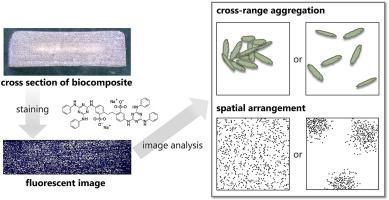当前位置:
X-MOL 学术
›
Compos. Sci. Technol.
›
论文详情
Our official English website, www.x-mol.net, welcomes your
feedback! (Note: you will need to create a separate account there.)
Fluorescent labeling and image analysis of cellulosic fillers in biocomposites: Effect of added compatibilizer and correlation with physical properties
Composites Science and Technology ( IF 8.3 ) Pub Date : 2020-09-01 , DOI: 10.1016/j.compscitech.2020.108277 Tatsuya Ogawa , Shinji Ogoe , Taka-Aki Asoh , Hiroshi Uyama , Yoshikuni Teramoto
Composites Science and Technology ( IF 8.3 ) Pub Date : 2020-09-01 , DOI: 10.1016/j.compscitech.2020.108277 Tatsuya Ogawa , Shinji Ogoe , Taka-Aki Asoh , Hiroshi Uyama , Yoshikuni Teramoto

|
Abstract The performance of cellulosic filler/polyolefin biocomposites is affected by the filler dispersion (aggregation and spatial arrangement) in the matrix. However, this mechanistic factor is generally inferred from the physical properties of the final bulk material because of the limitations of analytical techniques. Herein, we propose a simple method to quantitatively evaluate the dispersion of filler particles. To accomplish this, the cellulose component in injection-molded specimens of microcrystalline cellulose (MCC)/maleic anhydride-modified polypropylene (MAPP)/polypropylene (PP) composites was selectively fluorescently labeled with calcofluor white, and the dispersion state of tens of thousands of MCC particles observed by fluorescence microscopy was analyzed. The close-range aggregation behavior of the MCC particles can be evaluated by the area of the fluorescent particles (A), and the normality (randomness) of the spatial arrangement can be classified by the skewness of the distribution of the distances between the centroids of the particles (s). As a result, with an increase in the degree of acid modification of the added MAPP, aggregation of MCC was suppressed and the spatial arrangement became random. Both A and s were not associated with the modulus or fracture strain of the injection-molded specimens, but they were correlated with the tensile and bending strengths and water absorption behavior. This visualization method was also applied to a composite containing nanofibrillated cellulose filler (citric acid-modified cellulose nanofiber).
中文翻译:

生物复合材料中纤维素填料的荧光标记和图像分析:添加增容剂的影响及其与物理性质的相关性
摘要 纤维素填料/聚烯烃生物复合材料的性能受填料在基质中的分散(聚集和空间排列)的影响。然而,由于分析技术的限制,这种机械因素通常是从最终散装材料的物理特性中推断出来的。在此,我们提出了一种简单的方法来定量评估填料颗粒的分散性。为了实现这一目标,微晶纤维素 (MCC)/马来酸酐改性聚丙烯 (MAPP)/聚丙烯 (PP) 复合材料注塑样品中的纤维素组分被选择性荧光标记为 calcofluor 白,并且分散状态数以万计分析通过荧光显微镜观察到的MCC颗粒。MCC粒子的近距离聚集行为可以通过荧光粒子的面积(A)来评价,空间排列的正态性(随机性)可以通过质心间距离分布的偏度来分类。粒子(s)。结果,随着添加的 MAPP 的酸改性程度的增加,MCC 的聚集受到抑制,空间排列变得随机。A 和 s 都与注塑试样的模量或断裂应变无关,但它们与拉伸和弯曲强度以及吸水行为相关。这种可视化方法也适用于含有纳米原纤化纤维素填料(柠檬酸改性纤维素纳米纤维)的复合材料。空间排列的正态性(随机性)可以通过粒子(s)质心之间距离分布的偏度来分类。结果,随着添加的 MAPP 的酸改性程度的增加,MCC 的聚集受到抑制,空间排列变得随机。A 和 s 都与注塑试样的模量或断裂应变无关,但它们与拉伸和弯曲强度以及吸水行为相关。这种可视化方法也适用于含有纳米原纤化纤维素填料(柠檬酸改性纤维素纳米纤维)的复合材料。空间排列的正态性(随机性)可以通过粒子(s)质心之间距离分布的偏度来分类。结果,随着添加的 MAPP 的酸改性程度的增加,MCC 的聚集受到抑制,空间排列变得随机。A 和 s 都与注塑试样的模量或断裂应变无关,但它们与拉伸和弯曲强度以及吸水行为相关。这种可视化方法也适用于含有纳米原纤化纤维素填料(柠檬酸改性纤维素纳米纤维)的复合材料。随着添加的MAPP酸改性程度的增加,MCC的聚集受到抑制,空间排列变得随机。A 和 s 都与注塑试样的模量或断裂应变无关,但它们与拉伸和弯曲强度以及吸水行为相关。这种可视化方法也适用于含有纳米原纤化纤维素填料(柠檬酸改性纤维素纳米纤维)的复合材料。随着添加的MAPP酸改性程度的增加,MCC的聚集受到抑制,空间排列变得随机。A 和 s 都与注塑试样的模量或断裂应变无关,但它们与拉伸和弯曲强度以及吸水行为相关。这种可视化方法也适用于含有纳米原纤化纤维素填料(柠檬酸改性纤维素纳米纤维)的复合材料。
更新日期:2020-09-01
中文翻译:

生物复合材料中纤维素填料的荧光标记和图像分析:添加增容剂的影响及其与物理性质的相关性
摘要 纤维素填料/聚烯烃生物复合材料的性能受填料在基质中的分散(聚集和空间排列)的影响。然而,由于分析技术的限制,这种机械因素通常是从最终散装材料的物理特性中推断出来的。在此,我们提出了一种简单的方法来定量评估填料颗粒的分散性。为了实现这一目标,微晶纤维素 (MCC)/马来酸酐改性聚丙烯 (MAPP)/聚丙烯 (PP) 复合材料注塑样品中的纤维素组分被选择性荧光标记为 calcofluor 白,并且分散状态数以万计分析通过荧光显微镜观察到的MCC颗粒。MCC粒子的近距离聚集行为可以通过荧光粒子的面积(A)来评价,空间排列的正态性(随机性)可以通过质心间距离分布的偏度来分类。粒子(s)。结果,随着添加的 MAPP 的酸改性程度的增加,MCC 的聚集受到抑制,空间排列变得随机。A 和 s 都与注塑试样的模量或断裂应变无关,但它们与拉伸和弯曲强度以及吸水行为相关。这种可视化方法也适用于含有纳米原纤化纤维素填料(柠檬酸改性纤维素纳米纤维)的复合材料。空间排列的正态性(随机性)可以通过粒子(s)质心之间距离分布的偏度来分类。结果,随着添加的 MAPP 的酸改性程度的增加,MCC 的聚集受到抑制,空间排列变得随机。A 和 s 都与注塑试样的模量或断裂应变无关,但它们与拉伸和弯曲强度以及吸水行为相关。这种可视化方法也适用于含有纳米原纤化纤维素填料(柠檬酸改性纤维素纳米纤维)的复合材料。空间排列的正态性(随机性)可以通过粒子(s)质心之间距离分布的偏度来分类。结果,随着添加的 MAPP 的酸改性程度的增加,MCC 的聚集受到抑制,空间排列变得随机。A 和 s 都与注塑试样的模量或断裂应变无关,但它们与拉伸和弯曲强度以及吸水行为相关。这种可视化方法也适用于含有纳米原纤化纤维素填料(柠檬酸改性纤维素纳米纤维)的复合材料。随着添加的MAPP酸改性程度的增加,MCC的聚集受到抑制,空间排列变得随机。A 和 s 都与注塑试样的模量或断裂应变无关,但它们与拉伸和弯曲强度以及吸水行为相关。这种可视化方法也适用于含有纳米原纤化纤维素填料(柠檬酸改性纤维素纳米纤维)的复合材料。随着添加的MAPP酸改性程度的增加,MCC的聚集受到抑制,空间排列变得随机。A 和 s 都与注塑试样的模量或断裂应变无关,但它们与拉伸和弯曲强度以及吸水行为相关。这种可视化方法也适用于含有纳米原纤化纤维素填料(柠檬酸改性纤维素纳米纤维)的复合材料。











































 京公网安备 11010802027423号
京公网安备 11010802027423号